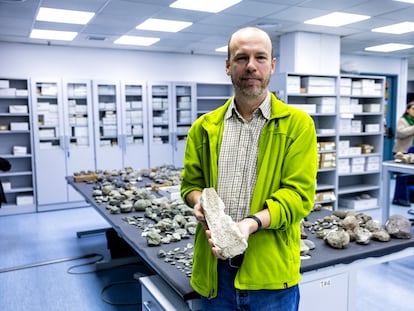
Poison in arrows from 60,000 years ago: Oldest evidence of its use in human weapons discovered
The finding in South Africa identifies toxic alkaloids in these projectiles, used for hunting during the Paleolithic era

The finding in South Africa identifies toxic alkaloids in these projectiles, used for hunting during the Paleolithic era

Around 16,000 new species are described each year, but most animals and plants are listed as threatened as soon as they are brought to light

Researchers say the remains of ‘Paranthropus boisei’ reveal that this ancient relative was capable of powerfully manipulating objects and food, climbing trees, and perhaps making tools

The Nobel Prize winner in Medicine is investigating genetic changes that could have given our species a competitive advantage, and the possibility of extracting the genome of the Flores hobbit

The fossils, attributed to an unknown australopithecus that lived in present-day Ethiopia 2.6 million years ago, have met with skepticism from other experts

A series of recent investigations suggests that the first human communities passed on their particular culinary traditions between generations

The new dating of an object found decades ago in Poland reinforces the idea that early humans in Central Europe had technological insight tens of thousands of years ago

DNA and protein analysis of a 146,000-year-old skull shows for the first time what the face of this species, which occupied much of Asia and left its genes in modern humans, was like

A new study comparing humans with other primates and rodents suggests that fur loss millions of years ago slowed the healing process in ‘Homo sapiens’

A study explores key aspects of gargalesis, such as why certain areas of the body are more sensitive, why children tend to be more susceptible, and what its possible evolutionary function might be
The behavior, which ends with the death of the young, was initiated by a young primate and imitated by others

Historical cases and scientific analysis show that the most common human reaction to disasters is to help others, a trait that defines our species and that authorities do not know how to channel

Researchers have found the oldest known bone tools, made by our ancestor ‘Homo erectus’

Fine sewing needles made from the bones of small animals such as foxes and mountain lions, which hunters used to make tailored garments during the last Ice Age, have been discovered in Wyoming

The bowstrings, dating from between 7,200 and 6,900 years ago, are made of braided animal tendons, a technique modern archers still employ

The American researcher talks to EL PAÍS about how walking upright was the starting point for our brain enlargement and our pro-social nature

A discovery in Kenya offers the first snapshot of peaceful coexistence between very different hominids

The fossil remains of the unique hominid were found in Ethiopia in 1974, traveled around the world, were the subject of controversy and became an icon of science. Even today they continue to provide answers to where we come from

The scientist argues that obesity is the result of an evolutionary mismatch between brain programming and our social context

Ancient humans who lived on an Indonesian island up to 50,000 years ago are believed to have descended from ‘Homo erectus,’ who became gradually smaller after arriving there a million years ago

The French author reflects on the identity of our species and our tendency to annihilate any other form of humanity

The latest discoveries about the two archaic human species closest to ours reflects constant genetic exchanges

The clans of this human species were smaller than previously thought, and were eventually absorbed by sapiens, according to a new DNA study

The discovery of a cave hunting scene indicates that rock art dates back even earlier than previously thought

The invention of these tools allowed humans to make multilayered clothing and perhaps even underwear to protect them during in the ice age, argue the authors of a new study

The discovery in Spain of the fossil of a six-year-old child with serious ear injuries suggests that their family took care of them without expecting anything in return

Of the more than 60 species of megafauna that existed during the last ice age, only eight remain and most are in critical danger of disappearing